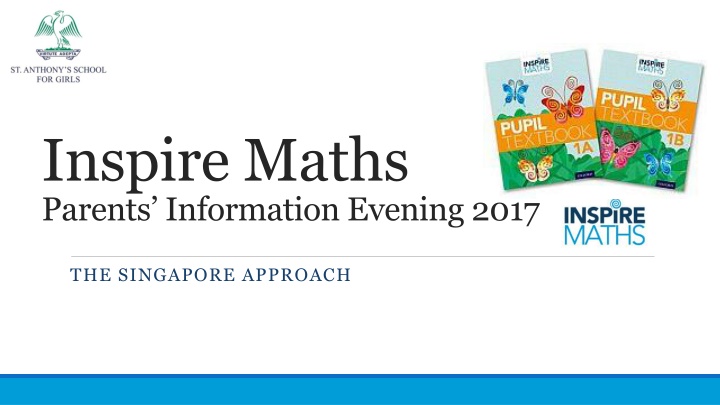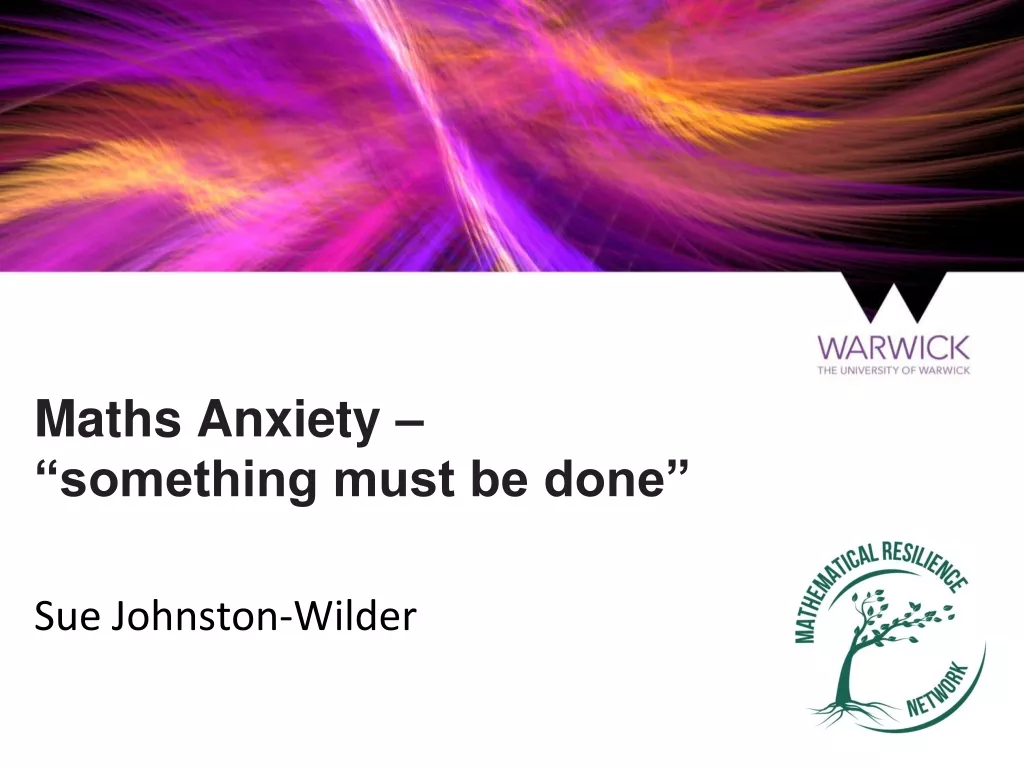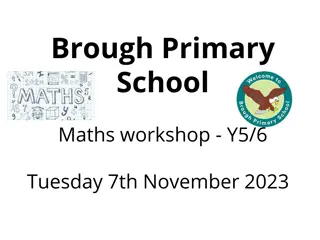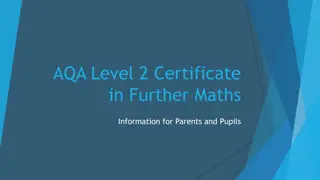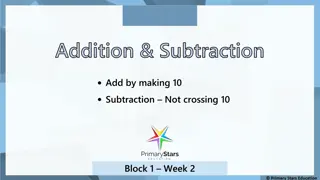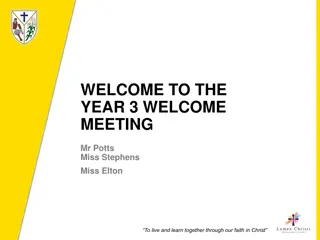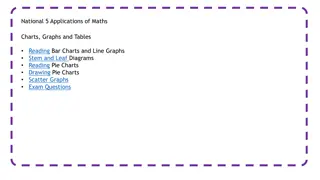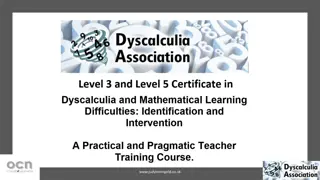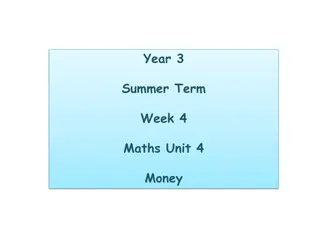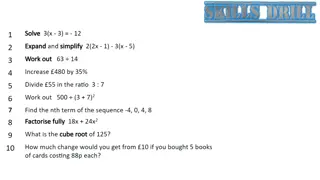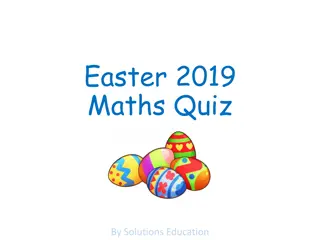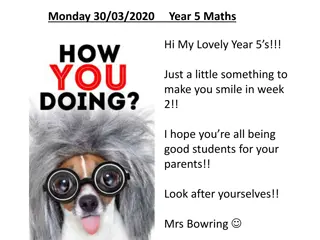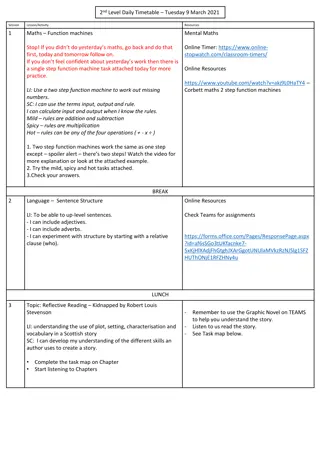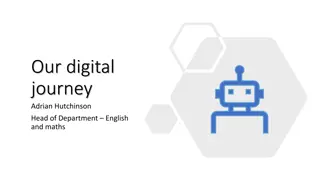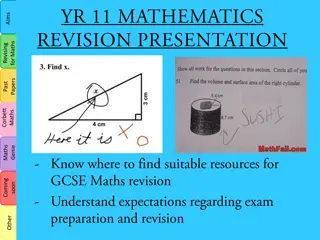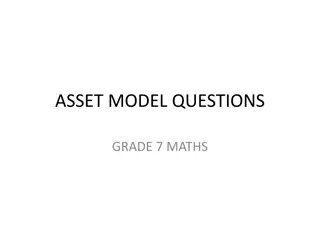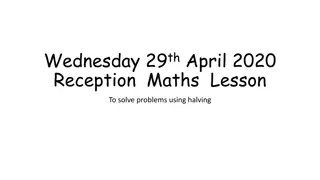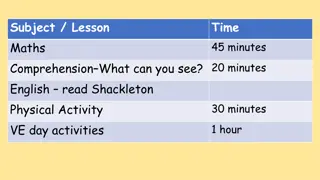Inspire Maths
Inspire Maths provides a scaffolded learning framework centered around problem solving. It features a spiral curriculum focused on building deep understanding through cumulative knowledge. The program emphasizes practice to develop fluency and mastery for all students, irrespective of abilities. Concrete and pictorial representations are strategically chosen to support learning, and high-quality textbooks are used to reinforce topics studied. The approach incorporates Bruner's forms of representations, C-P-A methodology, and a spiral curriculum proposed by Jerome Bruner, ensuring a comprehensive learning experience.
Download Presentation

Please find below an Image/Link to download the presentation.
The content on the website is provided AS IS for your information and personal use only. It may not be sold, licensed, or shared on other websites without obtaining consent from the author.If you encounter any issues during the download, it is possible that the publisher has removed the file from their server.
You are allowed to download the files provided on this website for personal or commercial use, subject to the condition that they are used lawfully. All files are the property of their respective owners.
The content on the website is provided AS IS for your information and personal use only. It may not be sold, licensed, or shared on other websites without obtaining consent from the author.
E N D
Presentation Transcript
Inspire Maths Parents Information Evening 2017 THE SINGAPORE APPROACH
What is Inspire Maths? Inspire Maths provides a highly scaffolded learning framework with problem solving at its heart. It is built on a focused, coherent and cumulative spiral curriculum that continuously builds and consolidates knowledge to reach deep understanding. The programme encourages extensive practice to develop fluency and mastery, so that every child-across all abilities can succeed at mathematics.
What are the characteristics of a child who is good at maths? INDEPENDENT LEARNER PATTERN SPOTTER RISK TAKER GROWTH MINDSET RESILIENT (I can t do it YET!!!!) SYSTEMATIC PERSISTENT EXPLORER
Textbooks.? A coherent programme of high quality curriculum materials is used to support classroom teaching. Concrete and pictorial representations of mathematics are chosen carefully to help build procedural and conceptual knowledge together. One medium for coherent curriculum materials is high quality textbooks. These have the additional advantage that pupils also use them to return to topics studied, for consolidation and revision. NCETM, Developing Mastery in Mathematics Tim Oates: Why Textbooks Count http://www.cambridgeassessment.org.uk/images/181744-why-textbooks-count-tim-oates.pdf
Bruners forms of representations Students learn a new skill by using concrete materials, reinforcement is achieved by going back and forth between the representations. Concrete Enactive internalised action. Pictorial Iconic this can also be sensory imagery. Abstract Symbolic arbitrary symbols (words, numerals)
C-P-A Children are expected to use and understand numbers, which are abstract concepts. Many children struggle with this and so their first experience of mathematics is confusing, leaving them with no solid foundation to build on for later learning. The CPA approach helps children achieve secure number sense what numbers really represent and how to use them mathematically. This is done through a series of carefully structured representations first using physical objects (concrete), then diagrams or pictures (pictorial), and ultimately using representations such as numerals (abstract).
Spiral Approach Jerome Bruner proposed a spiral curriculum. Students first learn a concept or topic intuitively. They then revisit the idea repeatedly, each time adding to what they have already mastered until full mastery. Reinforcing and strengthening students understanding when a subject matter is revisited. Initially it is enacted with concrete materials, later it is represented by models and then by abstract notation.
Bar Modelling The bar model is a step-by-step method that helps children to understand and extract the information within a calculation or word problem. By drawing a bar model, children translate a calculation or word problem into a picture. The approach helps children process information given in the problem, visualise the structure, make connections and solve the problem.
Why models? To help pupils to process the information in the question. (Read) Make sense of the question or problem. (Think and Plan) Just one of the ways to comprehend the problem & from the models, pupils will be able to work out the solution.
Bar Modelling Different types of models Discrete Model Part-Whole Model Comparison Model Ratio Model Change/Transforming Model or before and after model.
Discrete Model Representations not pictures. Each box represents 1 discrete item. Theo has 4 cars and 3 lorries. How many toys has he got? c c c c l l l Theo has got _____ toys.
Part-Whole Model Sofia has 107 sweets and Finley has 75 sweets. How many sweets do they have altogether? Represent this problem as a discrete model. ? Always a question mark where the answer goes this is what we are trying to find. 107 75
Part whole model for addition and subtraction The model represents a quantitative relationship among three variables: whole, part 1 and part 2. Given the values of any two variables, we can find the value of the third one by addition or subtraction. Whole Part 1 Part 2
Part-whole model - subtraction Michelle baked 112 cakes. She gave away 87 cakes. How many cakes did she have left? Michelle has _____ cakes left. 112 87 ?
William has 135 stamps. He has 60 less stamps than his brother. How many stamps do William and his brother have altogether? They have ____ stamps altogether. 135 +195 330 W 135 ? B 60 135
Comparison Model for addition and subtraction The model represents a quantitative relationship among three variables: larger quantity, smaller quantity and difference. Given the values of any two variables, we can find the value of the third one by addition or subtraction. Difference Smaller quantity Larger quantity
Comparison Models Bryan has 166 marbles. He has 40 more marbles than Christopher. How many marbles does Christopher have? 166 Christopher has ____ marbles. 40 ?
Part-whole model for multiplication and division The following part-whole model represents a whole divided into 3 equal parts: Whole part The model illustrates the concepts of multiplication as: = One part x Number of parts Whole
Models for multiplication and division Jerry has 60 marbles. Tom has 4 times as many marbles as Jerry. How many marbles do they have altogether? Jerry and Tom have ____ marbles altogether. 60 Jerry ? Tom
Multiplicative Comparison Models One quantity is a multiple of the other, e.g. Larger quantity Smaller quantity The larger quantity is 3 times as much as the smaller quantity, and the smaller quantity is equal to 1/3 of the larger quantity.
Ratio Model The following part-whole model shows a whole divided into 3 parts A, B and C in the ratio 2:3:4. Whole Part A Part B Part C The following comparison model shows three quantities A, B and C which are in ratio 2:3:4. A The ratio 2:3:4 means 2 units to 3 units to 4 units B C
Model Drawing Read the problem. Rewrite the question in sentence form leaving a gap for the answer. Think about what is being asked and which model supports the question. Draw the bars. Partition or chunk the bars and note which section represents the answer. Discuss the question and think about what is being asked. Write the answer in the sentence and check that the answer makes sense.
